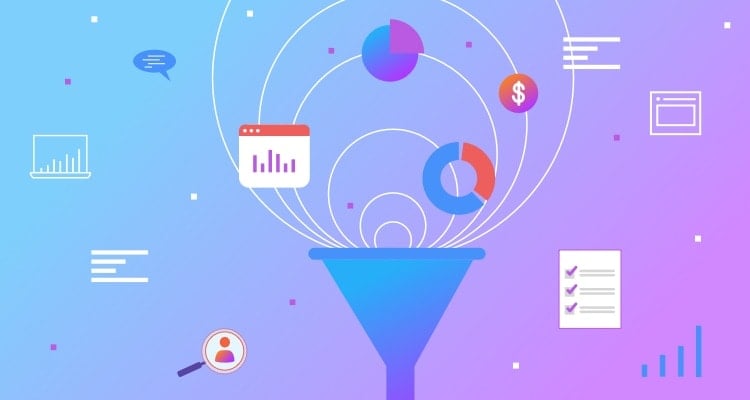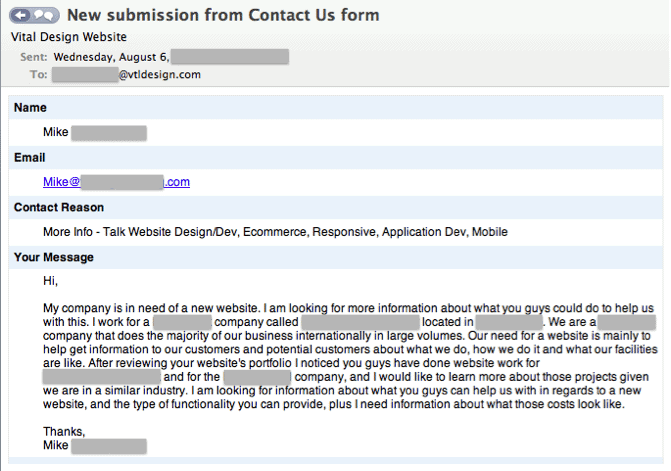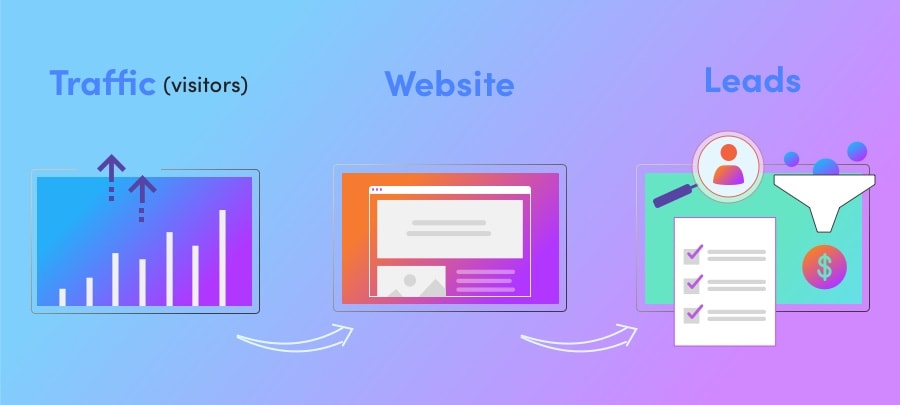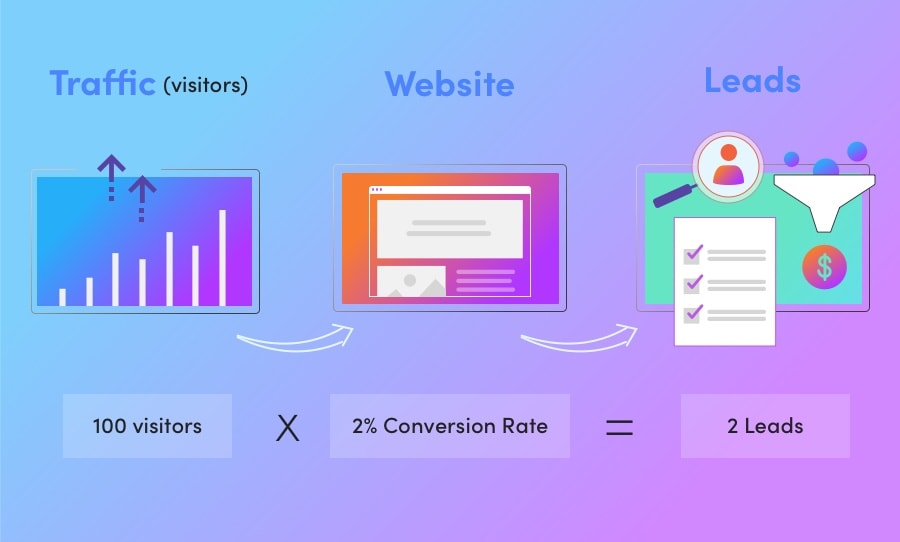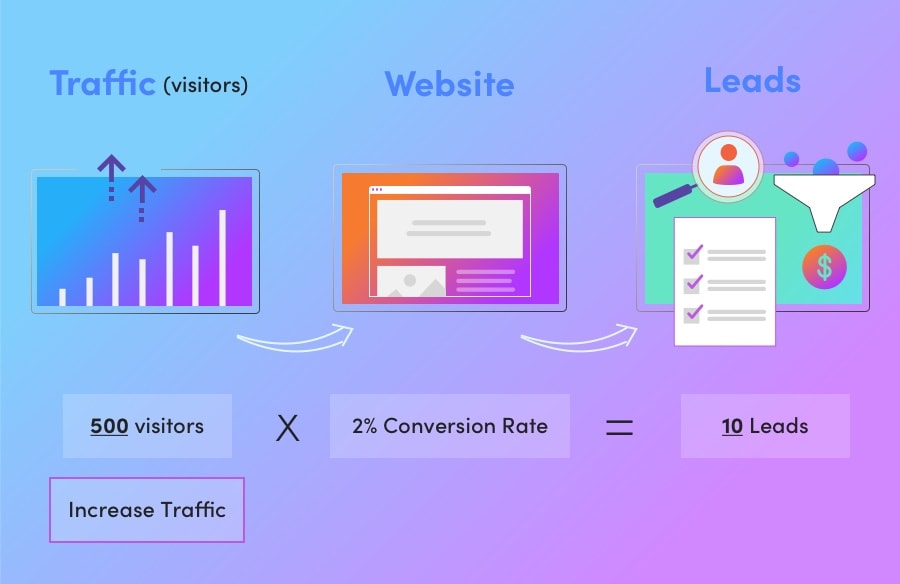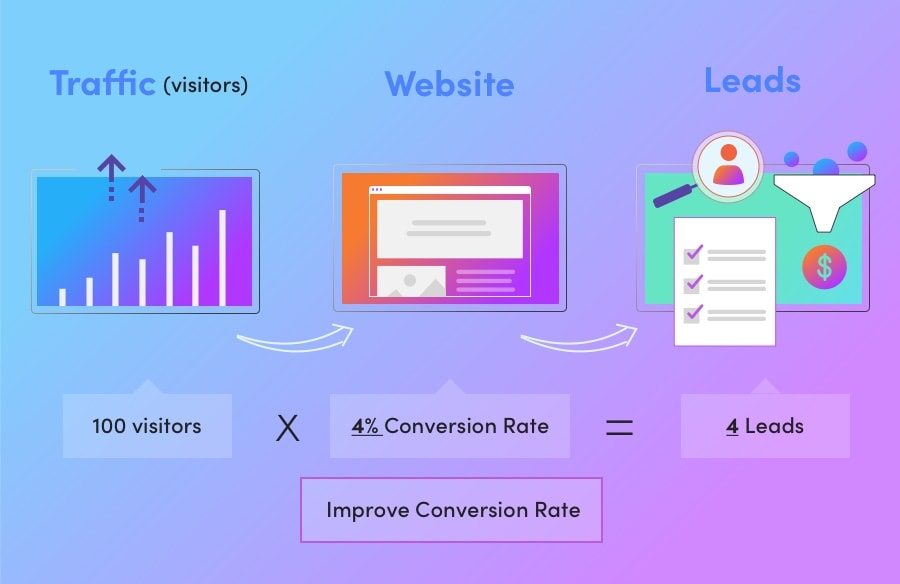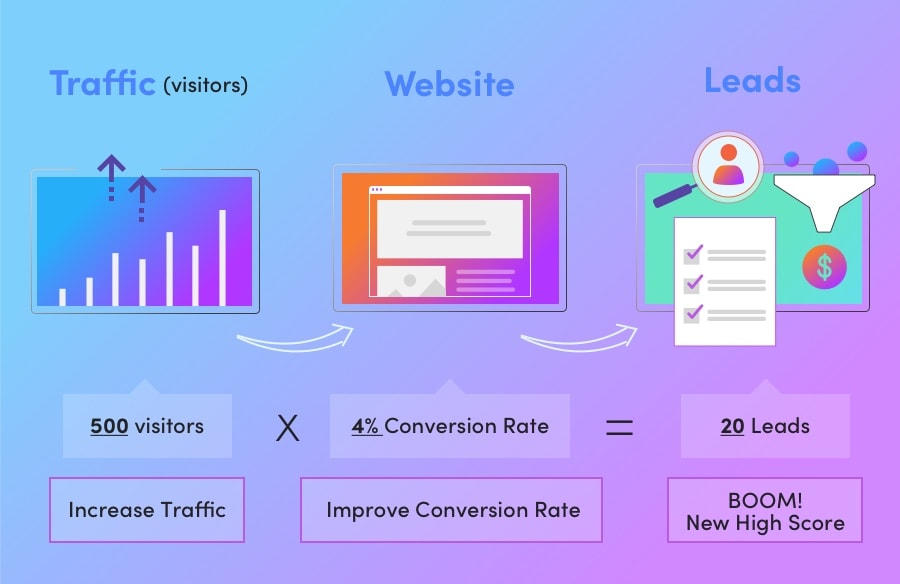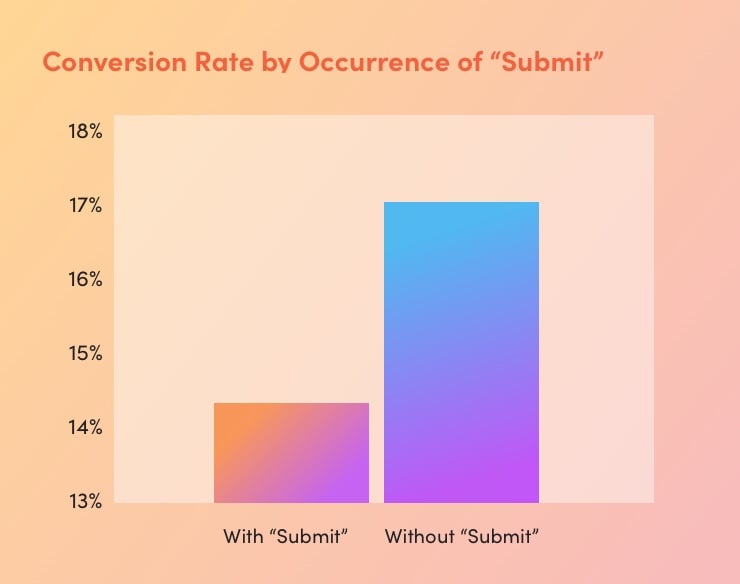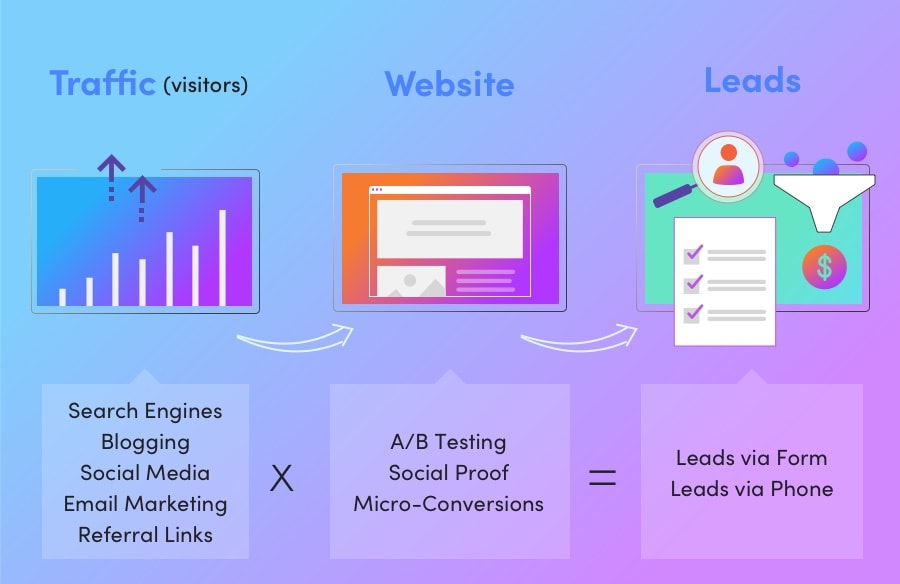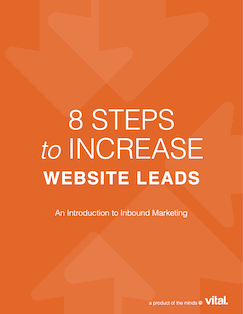Is your website driving leads for your business? High-quality leads that your sales team can close?
Most B2B companies struggle with creating online lead generation strategies through their website. They’re unsure where to begin and how to begin. But like all companies, they know they need leads — better leads, and more of them.
The Wild World of B2B Online Lead Generation
A report from Marketo states that “61% of B2B marketers cite generating high-quality leads as their No. 1 challenge.”
This is because leads are getting harder and harder to come by using traditional B2B marketing techniques like print ads and tradeshows. With fewer quality leads coming in and many marketing budgets remaining frozen, the cost per lead is increasing. So more and more marketers at B2B companies are turning to online means of sales lead generation.
But where does a company begin to navigate the complex world of B2B lead generation strategies? There are too many buzzwords to learn (inbound, tweet, impressions, convert, bounce rate, etc.), and too many acronyms to decipher (SEO, SEM, PPC, CRO, ESP, UX, etc.). So we’ve broken it down for you.
Where Do Online Leads Come From?
5 Ways to Increase Your Website Traffic
3 Ways to Improve Your Conversion Rate
Let’s Start at the Beginning: What Is a B2B Lead?
A lead is someone who has contacted you because they are interested in learning more about or purchasing your B2B company’s services or products.
These leads are people who are coming to your website and filling out forms to download information or contact you, or dialing your phone number (which they found on your website) to call you.
Before we go any further, let’s all get on the same page regarding two different types of B2B leads that your website might generate:
- Marketing qualified leads (MQLs) are people who are interested in learning more about your products or services. They might fill out a form with their contact information in exchange for a “premium content offer” — checklists, webinars, eBooks, and other valuable pieces of content that will help them make a purchasing decision.
- Sales qualified leads (SQLs) are ready to purchase the goods or services your B2B business provides. These are people who fill out a form to receive a quote or schedule an appointment with a sales consultant.
How do you convert MQLs into SQLs? With a strong email lead nurture campaign that leads prospects down the sales funnel with additional content, more offers, and so on, continuing to build trust and address empathy points until they are ready to talk to sales.
This is what a sales qualified lead generated from our website looks like:
This is a person who is ready to make a purchase, and could potentially hire our agency to build their website. They’re a sales qualified lead because they have a need in the near future for our products or services, and they have a budget allocated for this.
At this point, ideally the lead is interested in a follow-up call or meeting. Sales qualified leads are incredibly valuable to us as a B2B company.
Where Do Online B2B Leads Come From?
Your website. It all starts with your website.
If you don’t have a website, it will be nearly impossible to generate leads online. Your website should be the hub of all your future online marketing strategies and thus online lead generation activities.
Here’s the basic flow of how B2B website leads are generated online:
With your website being the central hub, it’s up to your marketing department to employ proven online marketing strategies to drive qualified traffic into your website.
Once the traffic is driven into your website, it’s your website’s job to turn those website visitors into leads. This is called “converting.” This means you convert a website visitor (who is a stranger to you) into a lead you can follow up with.
A website converts a visitor (stranger) into a lead by getting that visitor to provide their name and contact information via a website form (or getting them to call you on the phone and provide this information).
What is Your Website’s Conversion Rate?
This is simply the total number of leads generated from your website divided by the number of visitors to your website (over a set period of time).
Once this basic understanding is established, B2B online lead generation becomes a simple mathematical equation:
Makes sense, right? While this is an oversimplification, this is basically how online lead generation via a website works. In B2B companies, we generally see conversion rates between 2% and 6% — but this varies by industry.
What insightful marketers will immediately notice is the opportunity to increase the first two variables. Ideally, you will want to:
- Increase your website traffic
- Improve you website’s conversion rate
This is the lens through which all businesses should view online lead generation. So, it’s important to ask your marketing agency how they plan to increase your website traffic and conversion rates.
As savvy B2B marketers, we know we can increase the total of website traffic (visitors) to get more leads:
Simple logic, right? Just drive more traffic into your lead generation machine (your website). It’s important to note that this needs to be quality, relevant traffic.
The other option is to increase the website’s conversion rate to get more leads:
Again — simple, right? Make your lead generation machine (website) work better and convert at a higher rate. There are a number of ways to increase your conversion rate, which we will explain later in this post.
Then, of course, here’s what we really should do: Increase traffic and improve the conversion rate:
Now you know the equation and how to manipulate the numbers to crank out leads. But until now, we’ve only discussed equations and general numbers. You might ask, “But how do I actually go about increasing my website traffic and improving my website’s conversion rate?”
Great questions. Let’s tackle them!
5 Ways to Increase Your B2B Website’s Traffic
You increase your website traffic through “traffic driving tactics.” These tactics include:
- Blogging — Writing blog posts that feature your target keywords is a great way to help your website rank in search engines for those keywords. These posts are also useful for sharing on social media and sending out via email. For the most effective blog strategy, you’ll want to keep in mind something called “searcher intent” when you choose keywords and topics. Think about what people are interested in learning when they Google your chosen keywords, and be sure to deliver quality content that addresses those interests. (Rather than just blogging about your company and its products and services.) Pro tip: Blogging is particularly valuable for top-of-funnel (or TOFU) prospects. Capture people’s interest at an early stage in their buyer’s journey, and you can address their pain points and establish credibility — then offer them premium content to convert them into MQLs, followed by email lead nurture campaigns to convert them into SQLs! Depending on your particular business and your prospect’s buyer’s journey, you might even be able to drive traffic from your blog directly to your eCommerce store, which is why blogging is a critical part of any strategy to increase B2B eCommerce leads.
- Search Engine Optimization (SEO) — Get the technical aspects of your website in order so it’s easy for search engines like Google to crawl. This includes technical, buzzword-y things like setting up 301 redirects, optimizing meta descriptions and page titles, and fixing canonicalization errors. This also includes improving the overall usability of the site for your visitors. Pro tip: The “rules” of SEO are always changing, so it’s helpful to have an agency partner that understands the dynamic landscape of both on- and off-page SEO best practices. A common strategy that B2B lead generation agencies use to improve SEO is link building, or getting client content placed on high-authority websites with a link back to their own site. This tactic positions your business as a “thought leader” in Google’s eyes, which in turn increases your site rankings.
- Social Media Marketing — This includes participating in conversations your customers are already having on social media platforms like LinkedIn, Facebook, Instagram, and Twitter. By posting helpful content on social media, you can help drive those social media users back to your website. Pro tip: Social posting is great, but social selling is even better. When you post about your products or services on social media, chances are good that users will have questions (or concerns). It’s important to have sales reps answering questions promptly on social media to maximize leads that originate through these channels.
- Email Marketing — Sending helpful, informative emails to a qualified email list will drive those people to your website to learn more information. Sending your contact list a quick email telling them about a new blog post will drive them to your website to read an article they may have never known about otherwise. Pro tip: As we’ve mentioned, people who’ve already been converted into MQLs through a premium content offer should be entered into an email lead nurture campaign that goes above and beyond the standard emails to your marketing list. A good B2B lead generation agency will have experience setting up and running these campaigns.
- Referral Traffic — When you create helpful content (such as blog posts, webinars, or eBooks), and you tell the world about it (via social media and email), other websites may then link to it (as a reference). You will in turn receive traffic from their websites (and links!).
These tactics, implemented successfully, can increase the quality of the traffic visiting your website. And the key here is quality traffic because not all traffic is created equal.
eCommerce for B2B Lead Generation
According to a report by Forrester, U.S. B2B eCommerce will reach $1.8 trillion and account for 17% of all B2B sales by 2023. But, believe it or not, having an eCommerce store for your B2B business does more than just drive direct sales. It’s also an opportunity to boost SEO and drive more traffic to your website — which, if you recall, results in an increase in leads, whether or not a prospect places an order through your eCommerce store.
With an eCommerce store, B2B companies can optimize each SKU-specific page with product details, resources, and SEO copy to increase the likelihood of them showing up in product-specific searches. This presents an opportunity for B2B companies to rank on the first page of Google for each product they offer!
In B2B sales, customers often search for parts or components by the SKU number, material, industry, specifications, tolerances, and so on. Each product detail represents an opportunity for on-page SEO. Product pages on eCommerce sites also present opportunities to create separate pages that target specific keywords.
For example, your B2B eCommerce website could include:
- A page focused on a material (e.g. steel), which lists all the parts, tools, or products associated with that material.
- A page focused on a specific industry / vertical (e.g. construction) and the parts, tools, and components relevant to that industry.
- A page focused on specific tolerances or other specifications for a part, tool, or product.
Each of the above page examples represent a different search path a potential customer might take when looking for the same part, tool, or product. So, creating separate pages allows your company to drive organic traffic, while also building a well-constructed internal linking structure within the related product pages. Magic!
Pro tip: Writing detailed and unique product descriptions for eCommerce stores is a must. It’s easy to create a templated description and reuse it for similar products, but this will hurt your traffic in the end. Google looks for unique context about the usability of each product in order to increase its search rankings.
B2B Lead Generation Marketing Strategies
B2B online lead generation marketing focuses on driving quality traffic. When you drive quality traffic, the statistics are hard to ignore:
- B2B companies that blog generate 67% more leads per month than those that don’t. (Source: HubSpot)
- Marketers who prioritize blogging are 13x more likely to see a positive ROI. (Source: HubSpot)
- 47% of buyers viewed 3-5 pieces of content before engaging with a sales rep. (Source: HubSpot)
So, how do you get there? With a solid B2B lead generation marketing strategy, including these tactics:
Demand Generation Marketing
Who doesn’t want to generate demand for their products and services? Done right, this tactic works as well as it sounds. Demand generation marketing focuses on the awareness and consideration stage of the sales funnel.
The key to making it work for you? Long-term customer engagement. Beginning at the very early stages of your customer’s journey, establish empathy and address pain points to create awareness of your solution. If you can educate potential customers about what they’re missing out on without your company, you’re winning the demand generation marketing battle.
Growth Hacking
Roll up your sleeves. Growth hacking requires agility, creativity, and an uncompromising commitment to — you guessed it, growth. To get started, you need to pick your metrics. Choose the KPIs where you want to achieve growth, and get to work.
This might mean increasing social sharing by 50%. Or improving click through rate (CTR) on your paid search ads by 25%. Or…any number of other growth areas. The key is to make it concrete and measurable, and then to apply cross-disciplinary digital marketing tactics to get the job done. Growth hacking is an all-hands-on-deck affair that lets you tap into the brainpower of your marketing team to set goals, move the numbers, analyze, optimize, and repeat.
Content Marketing
Your blog is the beginning — but far from the end — of your content marketing strategy. Remember, the typical sales cycle of a B2B lead is much longer than in B2C. That’s because stakes tend to be higher, so customers take their time to make sure they’re choosing the right product or solution. Content marketing is a great way to generate leads and keep prospects engaged with your brand throughout their journey, while establishing the trust, empathy, and thought leadership that will ultimately lead to sales.
According to the Content Marketing Institute, “Content marketing is a strategic marketing approach focused on creating and distributing valuable, relevant, and consistent content to attract and retain a clearly defined audience — and, ultimately, to drive profitable customer action.”
Examples of content marketing include:
- Blog posts
- White papers
- eBooks
- Webinars
- Videos
- Case studies
- And any other content that provides value to your audience and helps generate leads and sales.
Account-based Marketing
Account-based marketing is a B2B lead generation tactic that focuses on specific high-value prospects rather than on marketing to a wider audience. In this approach, according to Marketo, “Marketing teams must employ strategies that meld the expertise of sales and marketing to locate, engage with, and close deals with high-value accounts that matter the most.”
That’s right — to practice account-based marketing, you’ll need to get your sales and marketing teams in the same room (and on the same page). You’ll see the payoff in improved ROI, more qualified leads, and ultimately more revenue.
3 Ways to Improve Your Website’s Conversion Rate
Let’s say you’re driving more traffic to your website — nice job! And let’s say your website converts at a 2% rate. To get more leads out of your traffic, you need to improve your conversion rate.
There are many ways to improve the conversion rate on your website, here are three examples:
1. A/B Testing
Quick: Are your website visitors more likely to click red buttons or green buttons? I bet you don’t know.
How about this one: Would more website visitors fill out your “Contact Us” form if you did not ask for their phone number on it? I bet you don’t know.
Don’t feel bad. Most businesses don’t know these things. They have not paid attention to how visitors behave on their website. But they should. By testing two different versions of the same website pages, business can learn what elements of a website will drive more leads.
Do you have forms on your website with a button that says “Submit?”
According to online lead generation research, website forms using the button text “Submit” have lower conversion rates than those who used other wording like “Contact Us Today” or “Click Here.”
Can you believe it? By simply changing the wording on your website’s buttons, you can improve your conversion rate and thus the number of leads you generate.
Additionally, you can try making other adjustments like:
- Removing the navigation bar
- Writing better headline copy
- Adding customer reviews
With these tweaks, your website’s conversion rates can increase by over 100%.
A/B testing certain elements on your site will allow you to convert more of the website traffic you already have. That’s the beauty of A/B testing — it seeks to convert more of your existing traffic, therefore getting you more conversions without needing to attract more traffic. Most of us in the inbound marketing world refer to this as conversion rate optimization.
2. Add Testimonials & Case Studies (Social Proof) To Your Website
No one wants to be a guinea pig. Your website visitors want to know that you’ve been successful with your current customers or clients before they buy your product or services.
By adding testimonials and case studies to your website, you show your website visitors that others have come before them, are happy with you, and trust you. It adds validation to your business.
This type of validation is known as social proof. This is the concept that people will conform to the actions of others because they believe those actions represent successful behavior. Basically, if other people are doing it and those other people are trustworthy, then your potential leads should be doing it too.
For example, if your target buyer is an HR director, prospects will feel more comfortable with your business after viewing testimonials and case studies featuring other HR directors they can relate to. These testimonials and case studies essentially serve as references for your business.
Take a look at this case study for a B2B company that increased their online lead generation by 1,286%.
3. Add Micro-Conversions
Most B2B websites offer their visitors one opportunity to convert and it’s usually via their main “Contact Us” form. That’s typically the only form on the website.
Let’s say, out of 100 website visitors, 2% of them fill out that contact form. And because that one form is the only conversion opportunity on the website, it sets the conversion rate for the entire website.
But what if you added another form on your website? Let’s say this new form allows your website visitors to download a recent whitepaper, eBook, or webinar you’ve created. And in order for your website visitors to download and view any of these items, they must first fill out a form providing their name, email, job title, and company name.
Bingo! You just created a brand-new conversion opportunity. A brand spanking new way to generate lead information from your website, without requiring those visitors to fill out the “Contact Us” form.
We call these things (whitepapers, eBooks, webinars) “micro-conversions,” because while they may not have filled out the main “Contact Us” form, they did fill out a form that provided your sales team with enough lead information to follow up on.
Let’s bring it back to math. Say you have 100 website visitors a month:
- 100 website visitors x 2% Contact Form Conversion Rate = 2 Leads
- 100 website visitors x 2% Whitepaper Form Conversion Rate = 2 Leads
- Total: 4 Leads
Now let’s say you added all three of the new micro-conversion strategies (whitepaper, eBook, and webinar):
- 100 website visitors x 2% Contact Form Conversion Rate = 2 Leads
- 100 website visitors x 2% Whitepaper Form Conversion Rate = 2 Leads
- 100 website visitors x 2% eBook Form Conversion Rate = 2 Leads
- 100 website visitors x 2% Webinar Form Conversion Rate = 2 Leads
- Total: 8 Leads
There it is! By adding more opportunities on your website for visitors to convert, you generate more potential leads.
With that, here’s what your new website lead generation equation looks like:
Summary
Now that you have a deeper understanding of how to get more online sales leads through your website, you’re ready to dive deeper into the world of inbound marketing.
And like all other companies, Vital depends on these leads to thrive and grow. We understand the importance of having an effective lead-generation strategy that leverages quality content and thought leadership. This is what puts us among the top inbound marketing agencies.
Just in case you’re not quite clear on what exactly inbound marketing is and does, check out this recent post written by our co-founder that explains Inbound Marketing vs. Outbound Marketing.
Contact us today to learn even more strategies on how to increase website traffic and improve your conversion rate to create more leads.
